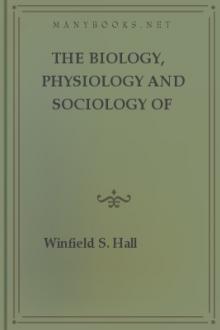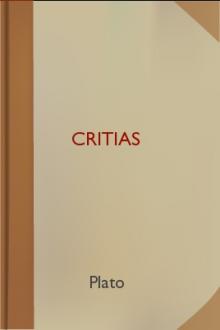Illusions, James Sully [speld decodable readers .TXT] 📗

- Author: James Sully
- Performer: -
Book online «Illusions, James Sully [speld decodable readers .TXT] 📗». Author James Sully
FIG. 4.
It follows from this that, with respect to the distant parts of a scene, pictorial art possesses the means of perfect imitation; and here we see that a complete illusory effect is obtainable. I need but to refer to the well-known devices of linear and aerial perspective, by which this result is secured.[40] The value of these means of producing illusion at the command of the painter, may be illustrated by the following fact, which I borrow from Helmholtz. If you place two pieces of cardboard which correspond to portions of one form at the sides and in front of a third piece, in the way represented above, so as just to allow the eye to follow the contour of this last, and then look at this arrangement from a point at some little distance with one eye, you easily suppose that it stands in front of the side pieces. The explanation of the illusion is that this particular arrangement powerfully suggests that the outline of the whole figure, of which the two side pieces are parts, is broken by an intervening object. Owing to the force of these and other suggestions, it is easy for the spectator, when attending to the background of a landscape painting, to give himself up for a moment to the pleasant delusion that he is looking at an actual receding scene.
In connection with pictorial delusion, I may refer to the well-known fact, that the eye in a portrait seems to follow the spectator, or that a gun, with its muzzle pointing straight outwards, appears to turn as the spectator moves.[41] These tricks of art have puzzled many people, yet their effect is easily understood, and has been very clearly explained by Sir D. Brewster, in the work already referred to (letter v.). They depend on the fact that a painting, being a flat projection only and not a solid, continues to present the front view of an object which it represents wherever the spectator happens to stand. Were the eye in the portrait a real eye, a side movement of the spectator would, it is evident, cause him to see less of the pupil and more of the side of the eyeball, and he would only continue to see the full pupil when the eye followed him. We regard the eye in the picture as a real eye having relief, and judge accordingly.
We may fall into similar illusions respecting distance in auditory perception. A change of wind, an unusual stillness in the air, is quite sufficient to produce the sense that sounding objects are nearer than they actually are. The art of the ventriloquist manifestly aims at producing this kind of illusion. By imitating the dull effect of a distant voice, he is able to excite in the minds of his audience a powerful conviction that the sounds proceed from a distant point. There is little doubt that ventriloquism has played a conspicuous part in the arts of divination and magic.
Misconception of Local Arrangement.
Let us now pass to a class of illusions closely related to those having to do with distance, but involving some special kind of circumstance which powerfully suggests a particular arrangement in space. One of the most striking examples of these is the erroneous localization of a quality in space, that is to say, the reference of it to an object nearer, or further off than the right one. Thus, when we look through a piece of yellow glass at a dull, wintry landscape, we are disposed to imagine that we are looking at a sunny scene of preternatural warmth. A moment's reflection would tell us that the yellow tint, with which the objects appear to be suffused, comes from the presence of the glass; yet, in spite of this, the illusion persists with a curious force. The explanation is, of course, that the circumstances are exceptional, that in a vast majority of cases the impression of colour belongs to the object and not to an intervening medium,[42] and that consequently we tend to ignore the glass, and to refer the colour to the objects themselves.
When, however, the fact of the existence of a coloured medium is distinctly present to the mind, we easily learn to allow for this, and to recognize one coloured surface correctly through a recognized medium. Thus, we appear to ourselves to see the reflected images of the wall, etc., of a room, in a bright mahogany table, not suffused with a reddish yellow tint, as they actually are—and may be seen to be by the simple device of looking at a small bit of the image through a tube, but in their ordinary colour. We may be said to fall into illusion here in so far as we overlook the exact quality of the impression actually made on the eye. This point will be touched on presently. Here I am concerned to show that this habit of allowing for the coloured medium may, in its turn, occasionally lead to plain and palpable illusion.
The most striking example of this error is to be met with among the curious phenomena of colour-contrast already referred to. In many of these cases the appearance of the contrasting colour is, as I have observed, due to a temporary modification of the nervous substance. Yet it is found that this organic factor does not wholly account for the phenomena. For example, Meyer made the following experiment. He covered a piece of green paper by a sheet of thin transparent white paper. The colour of this double surface was, of course, a pale green. He then introduced a scrap of grey paper between the two sheets, and found that, instead of looking whitish as it really was, it looked rose-red. Whatever the colour of the under sheet the grey scrap took the complementary hue. If, however, the piece of grey paper is put outside the thin sheet, it looks grey; and what is most remarkable is that when a second piece is put outside, the scrap inside no longer wears the complementary hue.
There is here evidently something more than a change of organic conditions; there is an action of experience and suggestion. The reason of our seeing the scrap rose-red in one case and neutral grey in another, is that in the first instance we vividly represent to ourselves that we are looking at it through a greenish veil (which is, of course, a part of the illusion); for rose-red seen through a greenish medium would, as a matter of fact, be light grey, as this scrap is. Even if we allow that there always exists after an impression of colour a temporary organic disposition to see the complementary hue, this does not suffice as an explanation of these cases; we have to conclude further that imagination, led by the usual run of our experience, is here a co-operant factor, and helps to determine whether the complementary tint shall be seen or not.
Misinterpretation of Form.
More complex and circumscribed associations take part in those errors which we occasionally commit respecting the particular form of objects. This has already been touched on in dealing with artistic illusion. The disposition of the eye to attribute solidity to a flat drawing is the more powerful in proportion to the familiarity of the form. Thus, an outline drawing of a building is apt to stand out with special force.
Another curious illustration of this is the phenomenon known as the conversion of the concave mould or matrix of a medal into the corresponding convex relief. If, says Helmholtz, the mould of a medal be illuminated by a light falling obliquely so as to produce strong shadows, and if we regard this with one eye, we easily fall into the illusion that it is the original raised design, illuminated from the opposite side. As a matter of fact, the visual impression produced by a concave form with the light falling on one side, very closely resembles that produced by a corresponding convex form with the light falling on the other side. At the same time, it is found that the opposite mode of conversion, that is to say, the transformation of the raised into the depressed form, though occurring occasionally, is much less frequent. Now, it may be asked, why should we tend to transform the concave into the convex, rather than the convex into the concave? The reader may easily anticipate the answer from what has been said about the deeply fixed tendency of the eye to solidify a plane surface. We are rendered much more familiar, both by nature and by art, with raised (cameo) design than with depressed design (intaglio), and we instinctively interpret the less familiar form by the more familiar. This explanation appears to be borne out by the fact emphasized by Schroeder that the illusion is much more powerful if the design is that of some well-known object, as the human head or figure, or an animal form, or leaves.[43]
Another illustration of this kind of illusion recently occurred in my own experience. Nearly opposite to my window came a narrow space between two detached houses. This was, of course, darker than the front of the houses, and the receding parallel lines of the bricks appeared to cross this marrow vertical shaft obliquely. I could never look at this without seeing it as a convex column, round which the parallel lines wound obliquely. Others saw it as I did, though not always with the same overpowering effect. I can only account for this illusion by help of the general tendency of the eye to solidify impressions drawn from the flat, together with the effect of special types of experience, more particularly the perception of cylindrical forms in trees, columns, etc.
It may be added that a somewhat similar illustration of the action of special types of experience on the perception of individual form may be found in the region of hearing. The powerful disposition to take the finely graduated cadences of sound produced by the wind for the utterances of a Iranian voice, is due to the fact that this particular form and arrangement of sound has deeply impressed itself on our minds, in connection with numberless utterances of human feeling.
Illusions of Recognition.
As a last illustration of comparatively passive illusions, I may refer to the errors which we occasionally commit in recognizing objects. As I have already observed, the process of full and clear recognition, specific and individual, involves a classing of a number of distinct aspects of the object, such as colour, form, etc. Accordingly, when in a perfectly calm state of mind we fall into illusion with respect to any object plainly visible, it must be through some accidental resemblance between the object and the other object or class of objects with which we identify it. In the case of individual identification such illusions are, of course, comparatively rare, since here there are involved so many characteristic differences. On the other hand, in the case of specific recognition there is ample room for error, especially in those kinds of more subtle recognition to which I have already referred. To "recognize" a person as a Frenchman or a military man, for example, is often an erroneous process. Logicians have included this kind of error under what they call "fallacies of observation."
Errors of recognition, both specific and individual, are, of course, more easy in the case of distant objects or objects otherwise indistinctly seen. It is noticeable in these cases that, even when perfectly cool and free from emotional excitement,





Comments (0)